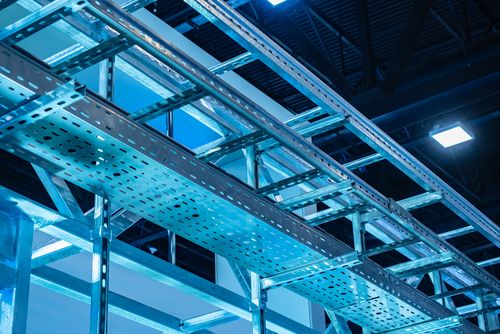Cable carrier systems are a key element in the construction industry that simplify, secure and facilitate cabling treatment.
Within this broad group are the cable trays, a simple device suitable for many scenarios, whose main functionalities are:
- Hold the wiring, both indoors and outdoors.
- Ensure the integrity of the cables, whatever their type (electricity, data cables, alarm systems...).
- Lead it in different directions, organizing the distribution of it.
- Protect from inclement weather, such as the temperatures to which the wiring will be exposed or the humidity of the environment.
- Provide safety to both operators and users, avoiding short circuits.
- Facilitate the installation of the wiring, as well as its subsequent maintenance thanks to the ability to properly classify and divide the cables they contain.
- As an alternative to the use of corrugated pipes, they also allow the replacement of old wiring. In addition, the cable trays are manufactured in various materials, providing a high degree of durability and adjustment to the characteristics of the project. They can be made of galvanized steel, stainless steel, aluminum, wire or plastic and this decision will largely depend on the final budget, as well as the life of the structure.
Depending on the type of tray chosen, these can be accompanied by protective caps or curves and leads that direct the cables and adapt the work to its structure.
Types of cable holder trays
PUK Portacables is specialized in offering solutions in areas such as Construction Technology, Energy, Infrastructure and Traffic, Industry, Oil and Gas. Depending on the sector and the specific needs of each project, the catalogue includes different types of cable trays:
- Trays of grate
- Perforated and blind trays
- Ladder trays
- Self-supporting systems
Multiple choice
Confirmed its great utility and high versatility, it is imperative to analyze the needs of the project where cable carrier systems are required: the section of the cables to be carried by tray and the characteristics of the environment will be the guides that will mark the decision. Subsequently, the type of energy to be transported and, with it, the purpose of this driving system must be taken into account. A useful option to divide the wiring into a single cable carrier system is the use of separators, which help to arrange and classify different materials within the tray itself. This option saves time, space and expenses, since the same structure is used.
In addition, and in situations where it is required by the location or by the weight of the wiring and the tray, the support can be an accessory of obligatory inclusion in the project. These are joists and parts of great support that guarantee the total fixation of the cable carrier system on any surface suitable for placement.
Paying attention to dimensions is vital in pre-installation decision making. The size of these systems is infinitely variable, as there are options for buildings of any type: homes, establishments, industry, ships, tunnels, etc. Starting from 30 millimeters to 6 meters in length, can cover thousands of meters of wiring if the project requires it. In fact, the biggest success stories in the history of PUK Portacables are large industrial or civil engineering works that required a large number of large cable trays.
Total adaptation
Years of progress and technology have resulted in multiple cable carriers, which now offer maximum customization and adaptation to each case and greater degree of ease in installation. One of the essential steps when choosing cable trays is to check the quality certification, which must guarantee ISO standards in terms of production and utility. This is only possible after successfully passing various controls concerning the safety and conditions of the materials.
Next to the cable trays are located all the necessary accessories for its installation, highlighting as a priority the fixing systems. These allow the anchoring between trays, reaching greater lengths and increasing the possibilities of cable direction.
PUK Portacables recommends contacting its experts to optimize the selection process and adapt the type of cable tray to use, ensuring the best shopping experience for the customer.
